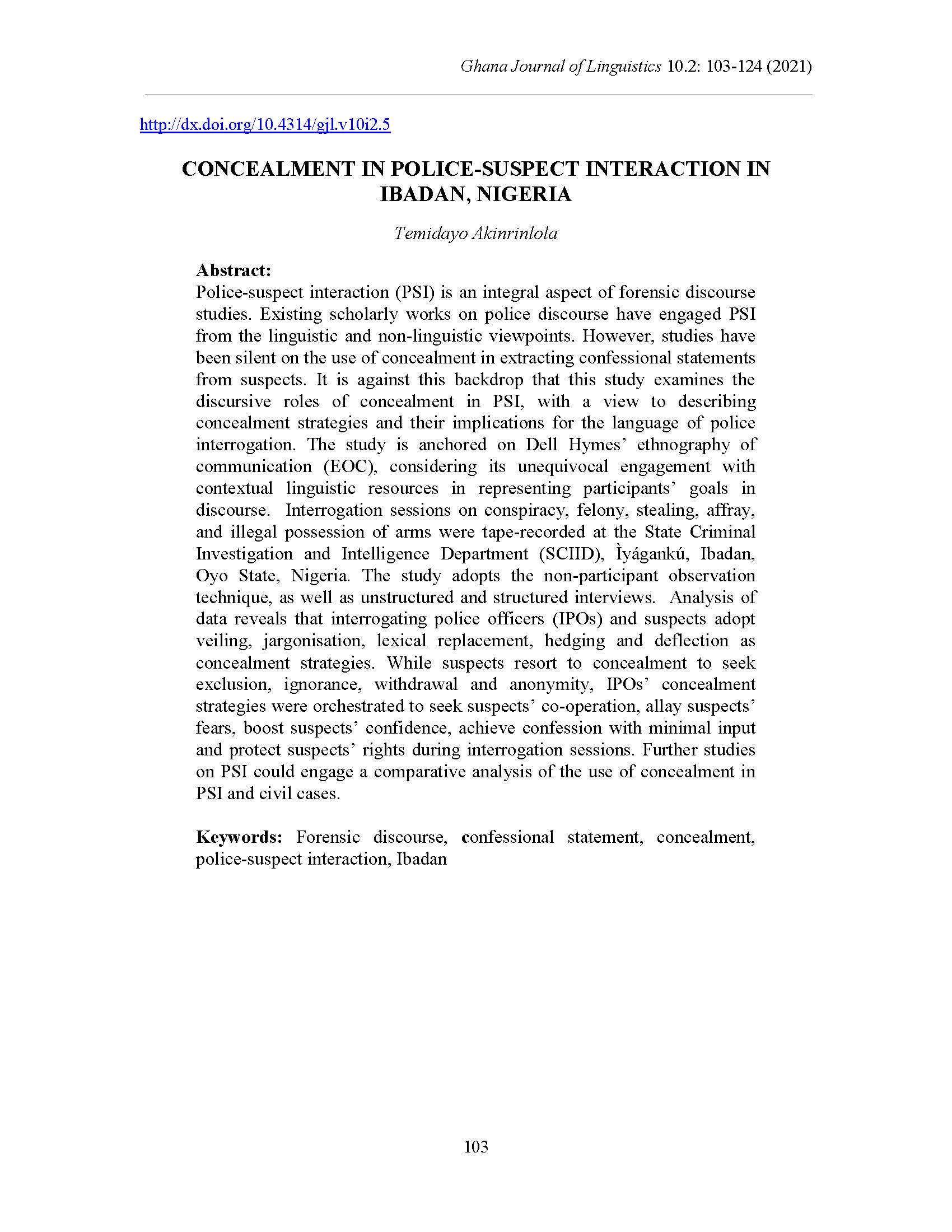Concealment in Police-Suspect Interaction in Ibadan, Nigeria
DOI:
https://doi.org/10.4314/gjl.v10i2.283Keywords:
Forensic discourse, confessional statement, concealment, police-suspect interaction, IbadanAbstract
Police-suspect interaction, henceforth, PSI, is an integral aspect of forensic discourse. Existing scholarly works have engaged PSI from the linguistic and non-linguistic viewpoints. However, studies have been silent on the role of concealment in extracting confessional statements from suspects. It is against this backdrop that this study examines the discursive roles of concealment in PSI with a view to describing concealment strategies and their implications in police interrogation. The study is anchored on Dell Hymes’ ethnography of communication (EOC), considering its unequivocal engagement with contextual linguistic resources in representing participants’ goals in discourse. Interrogation sessions on conspiracy, felony, stealing, affray, and illegal possession of arms were tape-recorded at the State Criminal Investigation Department, Iyaganku, Ibadan, Oyo State. The study adopts the non-participant observation technique, unstructured and structured interviews. A discursive engagement of Dell Hymes’ EOC in investigating concealment in PSI Ibadan, reveals that IPOs and suspects adopt veiling, jargonisation, lexical replacement, hedging and deflection as concealment strategies. While suspects resort to concealment to seek exclusion, ignorance, withdrawal and anonymity, IPOs’ concealment strategies were orchestrated to seek suspects’ co-operation, allay suspects’ fears, boost suspects’ confidence, achieve confession with minimal input and protect suspects’ rights during interrogation sessions. Further studies on PSI could engage a comparative analysis of the use of concealment in PSI and civil cases.
Key words: Forensic discourse, confessional statement, concealment, police-suspect interaction, Ibadan
References
Akinrinlola, T. (2018). Turn management strategies in police-suspect interaction in Ibadan, Nigeria. The Quint. 10 (3), 146-177
Akinrinlola, T. and Farinde, R.O. (2018) Topic change as a conversational strategy in police-suspect interaction in Ibadan, Nigeria. Journal of Linguistics and Language Education. 12 (2), 1-24
Akinrinlola, T. (2017). Deception in police-suspect interaction in Ibadan, Nigeria. Journal of Pan African Studies, California, 10 (1), 1-21
Asya, A. (2013). Linguistic manipulation: definition and types. International Journal of Cognitive Research Science, Engineering and Education. 2(1), 11-23
Aziz, R.N. & Al- Deleimi, A.D. (2018). The pragmatic strategies of concealment in Bush’s speech of announcing war against Iraq in 2003. International Journal of English Linguistics. 8 (4), 215-225
Carter, E.K. (2015). Police talk: an investigation into the interaction of the officer and the suspect in the police interview. International Journal of Speech Language and the Law. 16 (1). 23-45
Clark, H.H. (1992). Areas of language use. London: University of Chicago Press
Ekman, P. (1985). Telling lies: clues to deceit in the market place, marriage and politics. New York:WW Norton
Farinde, RO., Olajuyigbe, O.A., & Adegbite, M. (2015). Discourse control strategies in police-suspect interaction in Nigeria. International Journal of English Linguistics. 5 (1), 1-13
Fyke, J. (2014). Words as camouflage. Research at Marquette. Retrieved from https:llmed on 21st August, 2019.
Harworth, K. (2017). The discursive construction of evidence in police interviews: case study of a rape suspect. Applied Linguistics. 38 (2). 194-214
Hyland, K. 1998. Hedging in Scientific Research Articles. Amsterdam: Benjamins.
Hymes, D. (1972). Model of the interaction of language and social life (Revised from 1967 paper). In Gumperz and Hymes, (Eds). 1972. Directions in Sociolinguistic: The Ethnography of Communication. 35-71
John, D & Reising, M. (2017). Explaining procedural justice during police-suspect encounters. Policing. 40 (3), 574-586
Kahn, K.B., Steels, J.S. Mc Mahon, J.M.,& Stewart, G. (2017). How suspects’ race affects police use of force in an interaction. Law and Human Behaviour. 4 (2) 117-126
Karljn, B., Giebels, E. & Taylor, P.J. (2010). Patterns of interaction in police interviews. Criminal Justice Behaviour. 15 (2), 14-30
Mc Cornack, S. (1992). Information manipulation theory. Communication Monographs. 59 (1), 1-16
Metts, S. & Hippensteele, S. (1988). Characteristics of deception in close relationships. Advances in International Communication Research. 2(1), 33-50
Odebunmi, A. (2011). Concealment in consultative encounters in Nigerian hospitals. Pragmatics. 21 (4). 619-645
Omoroghomwan, B.O. (2018). Police behaviour and identification of criminals in Nigeria: a study of the South-South States. Sosyal Bilimler Metinleri. 2 (1),1-17
Richardson, J. E. 2007. Analysing newspapers. An approach from critical discourse analysis.
New York: Palgrave Macmillan.
Schroter, M. (2013). Silence and concealment in political discourse. Amsterdam: John Benjamins Publishers
Sunday, A.B. and Akinrinlola, T. (2017). Negotiation tactics in police-suspect
interaction in Ibadan, Nigeria. Journal of Communication and Language Arts. Vol. 8, (1), 161-181
Udoh, V.C. (2010). Linguistic features of the language of the Nigeria Police Force, Onitsha. An M.A. dissertation, Department of English, University of Nigeria, Nsukka

Downloads
Published
How to Cite
Issue
Section
License
Copyright (c) 2021 Temidayo Akinrinlola

This work is licensed under a Creative Commons Attribution 4.0 International License.
The Ghana Journal of Linguistics is published by the Linguistics Association of Ghana, P. O. Box LG 61, Legon, Accra, Ghana.
LAG Email: linguisticsgh@gmail.com. Website: http://www.laghana.org
GJL Email: gjl@laghana.org Website: http://www.laghana.org/gjl
© Linguistics Association of Ghana and individual authors, 2023.
